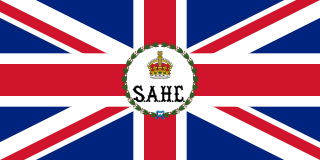Related Research Articles
The Batswana, a term also used to denote all citizens of Botswana, refers to the country's major ethnic group. Prior to European contact, the Batswana lived as herders and farmers under tribal rule.

Mafikeng, officially known as Mahikeng and alternatively known as Mafeking, is the capital city of the North West province of South Africa.

The Cape Colony, also known as the Cape of Good Hope, was a British colony in present-day South Africa named after the Cape of Good Hope. It existed from 1795 to 1802, and again from 1806 to 1910, when it united with three other colonies to form the Union of South Africa.

Basutoland was a British Crown colony that existed from 1884 to 1966 in present-day Lesotho. Though the Basotho and their territory had been under British control starting in 1868, the Cape Colony was unpopular and unable to control the territory. As a result, Basutoland was brought under direct authority of Queen Victoria, via the High Commissioner, and run by an Executive Council presided over by a series of British Resident Commissioners.

Hercules George Robert Robinson, 1st Baron Rosmead,, was a British colonial administrator who became the 5th Governor of Hong Kong and subsequently, the 14th Governor of New South Wales, the first Governor of Fiji, and the 8th Governor of New Zealand. From June 1859 until August 1896, he was known as Sir Hercules Robinson.

Sir Seretse Goitsebeng Maphiri Khama, GCB, KBE was a Botswanan politician who served as the first President of Botswana, a post he held from 1966 to his death in 1980.

The Bechuanaland Protectorate was a protectorate established on 31 March 1885, by the United Kingdom of Great Britain and Ireland in Southern Africa. It became the Republic of Botswana on 30 September 1966.

British Bechuanaland was a short-lived Crown colony of the United Kingdom that existed in southern Africa from its formation on 30 September 1885 until its annexation to the neighbouring Cape Colony on 16 November 1895. British Bechuanaland had an area of 51,424 square miles (133,190 km2) and a population of 84,210. Today the region forms part of South Africa.
Howard Unwin Moffat served as second premier of Southern Rhodesia, from 1927 to 1933.

South African Standard Time (SAST) is the time zone used by all of South Africa as well as Eswatini and Lesotho. The zone is two hours ahead of UTC (UTC+02:00) and is the same as Central Africa Time. Daylight saving time is not observed in either time zone. Solar noon in this time zone occurs at 30° E in SAST, effectively making Pietermaritzburg at the correct solar noon point, with Johannesburg and Pretoria slightly west at 28° E and Durban slightly east at 31° E. Thus, most of South Africa's population experience true solar noon at approximately 12:00 daily.

Sir Ralph Champneys Williams was a British colonial governor.

Stellaland was a short-lived Boer republic from 1882 until 1885, located in southern Bechuanaland, west of the then South African Republic, with Vryburg as its capital. It was incorporated in British Bechuanaland in 1885. British Bechuanaland was subsequently incorporated into the Cape of Good Hope in 1895.

The Cape of Good Hope General Service Medal is a British campaign medal which was awarded to members of the Cape Colonial Forces who took part in three campaigns in and around the Cape of Good Hope, in Basutoland in 1880–1881, in Transkei in 1880–1881 and in Bechuanaland in 1896–1897.

The British office of high commissioner for Southern Africa was responsible for governing British possessions in Southern Africa, latterly the protectorates of Basutoland, the Bechuanaland Protectorate and Swaziland, as well as for relations with autonomous governments in the area.

Sir Hamilton John Goold-Adams, was an Irish soldier and colonial administrator, who served as Governor of Queensland from 1915 to 1920.
This is a survey of the postage stamps and postal history of British Bechuanaland.

Goshen, officially known as the State of Goshen, was a short-lived Boer republic in southern Africa founded by Boers expanding west from Transvaal who opposed British advance in the region.

Bechuanaland first issued revenue stamps as Stellaland in 1884. Note: this information is wrong. Bechuanaland was split into British Bechuanaland and the Bechuanaland Protectorate. British Bechuanaland was added to the Cape Colony and the Bechuanaland Protectorate was governed from Mafeking until the seat of government was moved to Gaberone.
The Cape Mounted Police was the principal law enforcement agency of the Cape Colony during its last three decades. In addition to its ordinary policing duties, it was a para-military organisation, which saw active service in several campaigns and operations, including the Anglo-Boer War (1899–1902). The force was fully militarised in 1913 and transferred to the new South African Army as a mounted rifle regiment.
References
- ↑ Walker, Eric Anderson (1963). The Cambridge History of the British Empire. CUP Archive. p. 909. GGKEY:J4RZC934KC3.